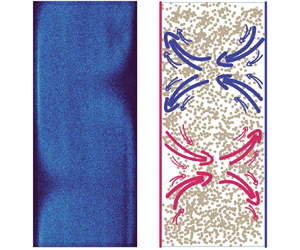Article contents
How do the finite-size particles modify the drag in Taylor–Couette turbulent flow
Published online by Cambridge University Press: 22 February 2022
Abstract

We experimentally investigate the drag modification by neutrally buoyant finite-size particles with various aspect ratios in a Taylor–Couette (TC) turbulent flow. The current Reynolds number,  $Re$, ranges from
$Re$, ranges from  $6.5\times 10^3$ to
$6.5\times 10^3$ to  $2.6\times 10^4$, and the particle volume fraction,
$2.6\times 10^4$, and the particle volume fraction,  $\varPhi$, is up to
$\varPhi$, is up to  $10\,\%$. Particles with three kinds of aspect ratio,
$10\,\%$. Particles with three kinds of aspect ratio,  $\lambda$, are used:
$\lambda$, are used:  $\lambda =1/3$ (oblate),
$\lambda =1/3$ (oblate),  $\lambda =1$ (spherical) and
$\lambda =1$ (spherical) and  $\lambda =3$ (prolate). Unlike the case of bubbly TC flow (van Gils et al., J. Fluid Mech., vol. 722, 2013, pp. 317–347; Verschoof et al., Phys. Rev. Lett., vol. 117, issue 10, 2016, p. 104502), we find that the suspended finite-size particles increase the drag of the TC system regardless of their aspect ratios. The overall drag of the system increases with increasing
$\lambda =3$ (prolate). Unlike the case of bubbly TC flow (van Gils et al., J. Fluid Mech., vol. 722, 2013, pp. 317–347; Verschoof et al., Phys. Rev. Lett., vol. 117, issue 10, 2016, p. 104502), we find that the suspended finite-size particles increase the drag of the TC system regardless of their aspect ratios. The overall drag of the system increases with increasing  $Re$, which is consistent with the literature. In addition, the normalized friction coefficient,
$Re$, which is consistent with the literature. In addition, the normalized friction coefficient,  $c_{f,\varPhi }/c_{f,\varPhi =0}$, decreases with increasing
$c_{f,\varPhi }/c_{f,\varPhi =0}$, decreases with increasing  $Re$, the reason could be that in the current low volume fractions the turbulent stress becomes dominant at higher
$Re$, the reason could be that in the current low volume fractions the turbulent stress becomes dominant at higher  $Re$. The particle distributions along the radial direction of the system are obtained by performing optical measurements at
$Re$. The particle distributions along the radial direction of the system are obtained by performing optical measurements at  $\varPhi =0.5\,\%$ and
$\varPhi =0.5\,\%$ and  $\varPhi = 2\,\%$. As
$\varPhi = 2\,\%$. As  $Re$ increases, the particles distribute more evenly in the entire system, which results from both the greater turbulence intensity and the more pronounced finite-size effects of the particles at higher
$Re$ increases, the particles distribute more evenly in the entire system, which results from both the greater turbulence intensity and the more pronounced finite-size effects of the particles at higher  $Re$. Moreover, it is found that the variation of the particle aspect ratios leads to different particle collective effects. The suspended spherical particles, which tend to cluster near the walls and form a particle layer, significantly affect the boundary layer and result in maximum drag modification. The minimal drag modification is found in the oblate case, where the particles preferentially cluster in the bulk region, and, thus, the particle layer is absent. Based on the optical measurement results, it can be concluded that, in the low volume fraction ranges (
$Re$. Moreover, it is found that the variation of the particle aspect ratios leads to different particle collective effects. The suspended spherical particles, which tend to cluster near the walls and form a particle layer, significantly affect the boundary layer and result in maximum drag modification. The minimal drag modification is found in the oblate case, where the particles preferentially cluster in the bulk region, and, thus, the particle layer is absent. Based on the optical measurement results, it can be concluded that, in the low volume fraction ranges ( $\varPhi =0.5\,\%$ and
$\varPhi =0.5\,\%$ and  $\varPhi = 2\,\%$ here), the larger drag modification is connected to the near-wall particle clustering. The present findings suggest that the particle shape plays a significant role in drag modification, and the collective behaviours of rigid particles provide clues to understand the bubbly drag reduction.
$\varPhi = 2\,\%$ here), the larger drag modification is connected to the near-wall particle clustering. The present findings suggest that the particle shape plays a significant role in drag modification, and the collective behaviours of rigid particles provide clues to understand the bubbly drag reduction.
- Type
- JFM Papers
- Information
- Copyright
- © The Author(s), 2022. Published by Cambridge University Press
References
REFERENCES
- 7
- Cited by



